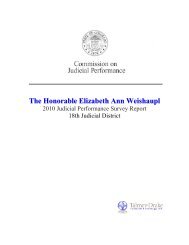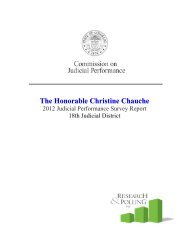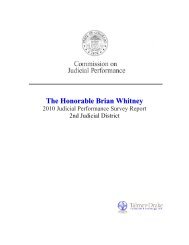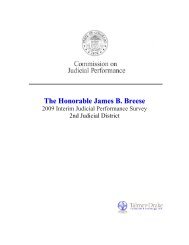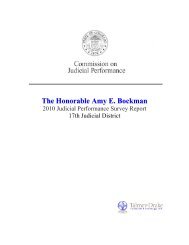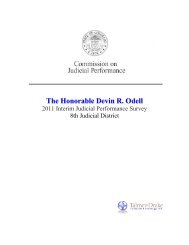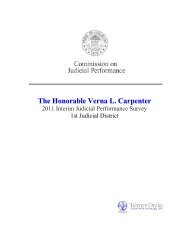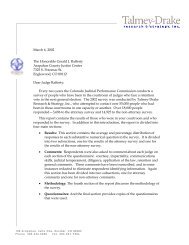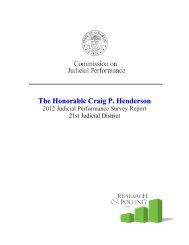The Honorable Ben W. McClelland - Mountain Legal â Colorado ...
The Honorable Ben W. McClelland - Mountain Legal â Colorado ...
The Honorable Ben W. McClelland - Mountain Legal â Colorado ...
Create successful ePaper yourself
Turn your PDF publications into a flip-book with our unique Google optimized e-Paper software.
State of <strong>Colorado</strong> LogoCOMMISSION ON JUDICIAL PERFORMANCE<strong>The</strong> <strong>Honorable</strong> <strong>Ben</strong> W. <strong>McClelland</strong>2010 Judicial Performance Survey Report14th Judicial District
March 30, 2010<strong>The</strong> <strong>Honorable</strong> <strong>Ben</strong> W. <strong>McClelland</strong>Grand County CourthouseP.O. Box 192Hot Sulphur Springs, CO 80451Dear Judge <strong>McClelland</strong>:I am pleased to make available to you the attached copy of your 2010 JudicialPerformance Survey Report. <strong>The</strong> report is based on two surveys relating to howyou are seen carrying out the performance of your office: One of attorneys who havehad cases in your court or who are knowledgeable about your judicial performance,and second a survey of non-attorneys who have observed your performance in courtor who have otherwise been affected by your performance of a judge.<strong>The</strong> methodology underlying these surveys has changed somewhat since the lastreports were issued in 2009. A few minutes perusing the methodology sectiontoward the end of this report should inform you of the relevant changes, andprovide you with a methodological context to better interpret your survey results.In addition to this introduction, the report is divided into five main sections:A brief summary of the results of the two surveys.<strong>The</strong> numerical results of the survey of attorneys in both tabular and graphicalform. In addition to the numerical results, this section also containscomments attorneys made about your judicial performance. In someinstances the comments have been redacted to eliminate respondentidentifying information. A copy of the attorney questionnaire is at the backof this report.<strong>The</strong> numerical results of the survey of non-attorneys in both tabular andgraphical form. In addition to the numerical results, this section also containscomments these respondent made on the subject of your judicialperformance. In few instances the comments have been redacted to eliminaterespondent identifying information. A copy of the non-attorneyquestionnaire is at the back of this report.<strong>The</strong> fourth section of the Report discusses the methodology of the surveys.<strong>The</strong> final section provides copies of the questions or questionnaires that wereused for each survey.1 00 Ar a p a h oe , Suit e O n e , Boul d er , C O 8 0 3 0 2P h o n e 3 0 3 . 4 4 3 . 5 3 0 0 F a x 303.200. 7385
Hon. <strong>Ben</strong> W. <strong>McClelland</strong>March 30, 2010Page 2If you have any questions about the methodology and how the survey wasconducted, please feel free to contact me at 303-443-5300 ext 1 or by email attalmey@talmeyresearch.com (please put the words “Judicial Performance” in thesubject line), and for any other questions you might have about the survey pleasecall the Executive Director of the Office of Judicial Performance Evaluation, JaneHowell, at 303-866-6465.Best regards,enc:Paul A. TalmeyPresident
Summary of ResultsAttorneys assigned Judge <strong>Ben</strong> W. <strong>McClelland</strong> an overall average grade 1 of 2.69, andnon-attorneys assigned Judge <strong>McClelland</strong> an overall average grade of 3.45 resulting in acombined grade of 3.07. <strong>The</strong> average combined grade for all county judges, includingthose not eligible to stand for retention in 2010, was 3.41. <strong>The</strong> combined average gradeis computed as the total of the overall average from the attorney survey plus the overallaverage from the non-attorney survey, divided by two.Judge <strong>McClelland</strong> Average GradeCombined Attorney Non-attorneyOverall Grade 3.07 2.69 3.45Sample Size - 17 204Table 1<strong>The</strong> results presented in this report are based on data collected in 2007, 2008 and 2009.(See Methodology section for description of sampling process.) Table 2 shows Judge<strong>McClelland</strong>’s overall average grades for each of these years.Judge <strong>McClelland</strong> Average Grades by YearCombined OverallAverage Score 2Attorney OverallAverage ScoreNon-Attny OverallAverage Score2007 2008 2009 2007 2008 2009 2007 2008 2009Overall Grade 3.18 2.82 2.75 2.40 3.60 3.61 3.24Sample Size - - - 0 9 8 34 63 107Table 21 <strong>The</strong> overall average grade for the attorney and non-attorney surveys are computed by summing the averagegrade for each A through F question and dividing by the number of questions. See the tables in each of the surveysections.2 County judges who were appointed between 2007 and 2009 will not have sample for the years prior to theirappointment. In the tables for those years with no sample, the sample size will be shown as 0, and the overallaverage cells will be blank. This will also be true for a few judges who had no attorney sample even though theywere on the bench that year.2010 Judicial Performance Survey Report1
Due to sending questionnaires to all jurors—not just a sample—and their much higherresponse rate than other non-attorneys surveyed, the percentage of jurors in the countyjudge sample of the non-attorney survey is 47%. Moreover, jurors tend to grade judgesmuch higher than non-jurors. <strong>The</strong> average juror overall average grade for county judgeswas 3.82, while the overall average grade awarded by non-jurors was 3.26. <strong>The</strong> effect ofthis is that judges with a higher percentage of jurors in their sample tend to have higheraverage grades in the non-attorney survey than those judges with a small percentage ofjurors. <strong>The</strong> number of jurors in a judge’s sample is, of course, closely related to thenumber of jury trials the judge presides over.<strong>The</strong> table below shows Judge <strong>McClelland</strong>’s non-attorney results broken out by jurorsand non-jurors. It also shows the overall average juror and non-juror grades for allcountyJudge <strong>McClelland</strong> Average Grade by Juror/Non-jurorJurorsNon-JurorsOverall Grade 3.81 2.86Percent of Sample 61% 39%Sample Size 124 80County Judge Average 3.82 3.26Table 3judges. Table 3 allows one to compare Judge <strong>McClelland</strong>’s juror and non-juror gradeswith the all county judge averages to better ascertain if the judge is seen as performingrelatively well or relatively poorly among these two subgroups.2010 Judicial Performance Survey Report2
Survey of Attorneys RegardingJudge <strong>Ben</strong> W. <strong>McClelland</strong>(Sample Size 17)
Survey of Attorneys Regarding Trial JudgesJudge <strong>Ben</strong> W. <strong>McClelland</strong>Sample Size = 17A B C D Fail DK/NAAverage<strong>Ben</strong> W.<strong>McClelland</strong>All CountyJudges1. Case Management:1a. Promptly issuing a decision on the case after trial. 41% 6% 18% 6% 0% 29% 3.17 3.491b. Maintaining appropriate control over proceedings. 41% 24% 12% 12% 6% 6% 2.88 3.431c. Promptly ruling on pre-trial motions. 47% 18% 12% 0% 6% 18% 3.21 3.371d. Setting reasonable schedules for cases. 59% 12% 18% 0% 0% 12% 3.47 3.372. Application and Knowledge of Law:Overall Case Management3.18 3.422a. Being able to identify and analyze relevant facts. 18% 41% 12% 18% 6% 6% 2.50 3.262b. Basing decisions on evidence and arguments. 29% 29% 18% 6% 12% 6% 2.63 3.132c. Willing to reconsider error in fact or law. 12% 6% 6% 12% 12% 53% 1.88 3.042d. Issuing consistent sentences when the circumstances aresimilar.22% 11% 33% 11% 0% 22% 2.57 3.243. Communications:Overall Application and Knowledge of Law2.40 3.173a. Making sure all participants understand the proceedings. 35% 18% 18% 18% 6% 6% 2.63 3.523b. Providing written communications that are clear, thorough 33% 8% 17% 8% 17% 17% 2.40 3.24and well reasoned.4. Demeanor:Overall Communications2.52 3.384a. Giving proceedings a sense of dignity. 29% 18% 24% 12% 12% 6% 2.44 3.424b. Treating parties with respect. 41% 18% 6% 12% 18% 6% 2.56 3.384c. Conducting his/her courtroom in a neutral manner. 41% 24% 6% 12% 12% 6% 2.75 3.234d. Consistently applying laws and rules. 35% 18% 6% 18% 12% 12% 2.53 3.245. Diligence:5a. Using good judgment in application of relevant law andrules.5b. Doing the necessary homework and being prepared forhis/her cases.5c. Being willing to handle cases on the docket even whenthey are complicated and time consuming.Overall Demeanor2.57 3.3229% 24% 12% 18% 12% 6% 2.44 3.1835% 12% 29% 6% 6% 12% 2.73 3.2641% 12% 24% 0% 6% 18% 3.00 3.37Overall Diligence2.72 3.27Overall Average Grade:2.69 3.312010 Judicial Performance Survey Report4
Survey of Attorneys Regarding Trial JudgesJudge <strong>Ben</strong> W. <strong>McClelland</strong><strong>Ben</strong> W.Sample Size = 17Percentage<strong>McClelland</strong>All CountyJudgesWould you say the judge is:Very biased in favor of the prosecutionSomewhat biased in favor of the prosecutionCompletely neutralSomewhat biased in favor of the defenseVery biased in favor of the defenseDon't know or not sure40% 10%20% 29%40% 48%0% 6%0% 2%0% 5%8. How strongly do you recommend that the Judge be retained in office, or not beretained in office?[Percentages excluding undecided responses.]Strongly recommend retainSomewhat recommend retainSomewhat recommend not retainStrongly recommend not retain50% 71%19% 16%19% 6%13% 7%Total RetainTotal Not Retain69%32%87%13%[Percentages including undecided responses.]Strongly recommend retainSomewhat recommend retainUndecided or Don't KnowSomewhat recommend not retainStrongly recommend not retain47% 67%18% 15%6% 5%18% 6%12% 7%Total Retain 65% 82%Undecided/Don't Know 6% 5%Total Not Retain 30% 13%2010 Judicial Performance Survey Report5
Judge <strong>Ben</strong> W. <strong>McClelland</strong>Survey of Attorneys Regarding Trial JudgesAverage GradesOverall Average Grade2.693.31Q1. Overall Case Management1a. Promptly issuing a decision on thecase after trial.3.183.173.423.491b. Maintaining appropriate control overproceedings.2.883.431c. Promptly ruling on pre-trial motions.1d. Setting reasonable schedules for cases.3.213.373.373.47Q2. Overall App & Knowledge of Law2a. Being able to identify and analyzerelevant facts.2.402.503.173.262b. Basing decisions on evidence and argument.2.633.132c. Willing to reconsider error in fact or law.3.042d. [Criminal only] Issuing consistant sentenceswhen circumstances are simmilar.2.573.24Q3. Overall Communication2.523.383a. Making sure all participants understandthe proceedings.2.633.523b. Providing written communications that areclear, thorough and well reasoned.2.403.242.0 2.5 3.0 3.5 4.0<strong>Ben</strong> W. <strong>McClelland</strong>All County Judges2010 Judicial Performance Survey ReportJudge <strong>Ben</strong> W. <strong>McClelland</strong>6
Judge <strong>Ben</strong> W. <strong>McClelland</strong>Survey of Attorneys Regarding Trial JudgesAverage GradesQ4. Overall Demeanor2.573.324a. Giving proceedings a sense of dignity.2.443.424b. Treating participants with respect.2.563.384c. Conducting [his/her] courtroomin a neutral manner.2.753.234d. Consistanly applying laws and rules.2.533.24Q5. Overall Diligence2.723.275a. Using good judgement in application ofreleveant laws and rules.2.443.185b. Doing the necessary 'homework' andbeing prepared for [his/her] cases.2.733.265c. Being willing to handle cases on the docket evenwhen they are complicated and time consuming.3.003.372.0 2.5 3.0 3.5 4.0Biased in favor of prosecution/defense.Very biased in favor of the prosecutionSomewhat biased in favor of the prosecutionCompletely NeutralSomewhat biased in favor of the defenseVery biased in favor of the defenseDon't know/not sure0%6%0%2%0%5%10%20%29%40%40%48%0% 10% 20% 30% 40% 50% 60%<strong>Ben</strong> W. <strong>McClelland</strong>All County Judges2010 Judicial Performance Survey Report7
Judge <strong>Ben</strong> W. <strong>McClelland</strong>Survey of Attorneys Regarding Trial JudgesQ8. How strongly do you recommend that Judge <strong>McClelland</strong> be retained or notretained in office?Excluding Undecided RespondentsStrongly recommend retain50%71%Somewhat recommend retainSomewhat recommend not retain6%19%16%19%Judge<strong>McClelland</strong>All CntyJudgesTotal Retain 69% 87%Total Not Retain 32% 13%Strongly recommend not retain7%13%0% 10% 20% 30% 40% 50% 60% 70% 80% 90% 100%Including Undecided RespondentsStrongly recommend retain47%67%Somewhat recommend retainUndecided or DKSomewhat recommend not retain6%5%6%18%15%18%Judge<strong>McClelland</strong>All CntyJudgesTotal Retain 65% 82%Undecided or DK 6% 5%Total Not Retain 30% 13%Strongly recommend not retain7%12%0% 10% 20% 30% 40% 50% 60% 70% 80% 90% 100%<strong>Ben</strong> W. <strong>McClelland</strong>All County Judges2010 Judicial Performance Survey Report8
Survey of Non-Attorneys RegardingJudge <strong>Ben</strong> W. <strong>McClelland</strong>(Sample Size 204)
Survey of Non-Attorneys Regarding Trial JudgesJudge <strong>Ben</strong> W. <strong>McClelland</strong>Sample Size = 204A B C D Fail DK/NAAverage<strong>Ben</strong> W.<strong>McClelland</strong>All CountyJudges1. Demeanor:1a. Giving court proceedings a sense of dignity. 68% 19% 5% 3% 3% 1% 3.46 3.541b. Treating participants in the case politely and with respect. 69% 17% 5% 3% 6% 0% 3.38 3.551c. Conducting court in a neutral manner. 68% 17% 5% 4% 4% 1% 3.42 3.501d. Having a sense of compassion and human understandingfor those who appear before the court.58% 21% 6% 4% 7% 3% 3.22 3.422. Fairness:Overall Demeanor3.37 3.502a. Giving participants an opportunity to be heard. 70% 16% 7% 2% 3% 0% 3.48 3.552b. Treating those involved in the case without bias. 67% 16% 4% 4% 7% 1% 3.35 3.462c. Treating fairly people who represent themselves. 50% 10% 2% 4% 3% 30% 3.43 3.462d. Giving each side enough time to present his or her case. 70% 14% 6% 3% 1% 5% 3.55 3.553. Communications:Overall Fairness3.45 3.513a. Making sure participants understand the proceedings, and 71% 18% 5% 2% 2% 2% 3.58 3.60what is going on in the courtroom.3b. Using language that everyone can understand. 71% 20% 5% 2% 2% 0% 3.55 3.633c. Speaking clearly so everyone in the courtroom can hearwhat is being said.74% 16% 6% 1% 2% 0% 3.59 3.664. Diligence:Overall Communications3.57 3.634a. Beginning court on time 59% 24% 8% 4% 1% 5% 3.42 3.394b. Maintaining appropriate control over proceedings. 72% 19% 5% 2% 1% 0% 3.59 3.644c. Setting reasonable schedules for cases. 56% 17% 8% 3% 2% 14% 3.41 3.524d. Being prepared for cases. 66% 16% 5% 2% 2% 8% 3.54 3.564e. Managing court proceedings so that there is little wastedtime.57% 27% 9% 3% 2% 2% 3.34 3.455. Application of Law:Overall Diligence3.46 3.515a. Giving reasons for rulings. 65% 17% 4% 3% 3% 7% 3.48 3.445b. Willing to make decisions without regard to possible 61% 10% 4% 2% 6% 17% 3.42 3.47outside pressure.5c. Being able to identify and analyze relevant facts. 65% 16% 4% 4% 5% 6% 3.41 3.45Overall Application of Law3.44 3.45Overall Average Grade:3.45 3.522010 Judicial Performance Survey Report10
Survey of Non-Attorneys Regarding Trial JudgesJudge <strong>Ben</strong> W. <strong>McClelland</strong>Sample Size = 204Percentage<strong>Ben</strong> W.<strong>McClelland</strong>All CountyJudges6. How biased do you think the Judge is toward the defense or prosecution?[Please see the questionnaire at the end ofreport for question wording.][A positive average indicates bias toward prosecution, and anegative average indicates a bias toward the defense.]Biased in favor of the prosecution totalCompetely neutralBiased in favor of the defense totalAverage19% 14%75% 78%7% 8%0.33 0.147. How lenient or harsh do you think the sentences generally handed down by Judgeare?[Please see the questionnaire at the end ofreport for question wording.][A positive average indicates sentences are harsh, and anegative average indicates sentences are lenient.]Harsh sentencing totalCompetely neutralLenient sentencing totalAverage24% 13%70% 74%8% 12%0.63 0.1110. How strongly do you recommend that the Judge be retained or not retained inoffice?[Percentages excluding undecided responses.]Strongly recommend retainSomewhat recommend retainSomewhat recommend not retainStrongly recommend not retain80% 82%7% 9%4% 3%8% 6%Total RetainTotal Not Retain87%12%91%9%[Percentages including undecided responses.]Strongly recommend retainSomewhat recommend retainUndecided or Don't KnowSomewhat recommend not retainStrongly recommend not retain72% 75%7% 8%10% 9%4% 3%8% 6%Total Retain 79% 83%Undecided/Don't Know 10% 9%Total Not Retain 12% 9%2010 Judicial Performance Survey Report11
2010 Judicial Performance Survey Report12
<strong>Ben</strong> W. <strong>McClelland</strong>All County Judges<strong>Ben</strong> W. <strong>McClelland</strong>All County JudgesJudge <strong>Ben</strong> W. <strong>McClelland</strong>Survey of Non-Attorneys Regarding Trial JudgesAverage GradesQ4. Overall Diligence4a. Beginning court on time.4b. Maintaining appropriate control overproceedings.4c. Setting reasonable schedules for cases.4d. Being prepared for his or her cases.4e. Managing court proceedings so that there islittle wasted time.3.463.513.423.393.593.643.413.523.543.563.343.45Q5. Overall <strong>Legal</strong> Ability5a. Giving reasons for rulings.5b. Willing to make decision without regard topossible outside pressure.5c. Being able to identify and analyzerelevant facts.3.443.453.483.443.423.473.413.452.0 2.5 3.0 3.5 4.0Q6 Biased in favor of prosecution/defense.0.330.14-5 -4 -3 -2 -1 0 1 2 3 4 5DefenseProsecution Q7 Lenience or Harshness in Sentencing.0.630.11-5 -4 -3 -2 -1 0 1 2 3 4 5Lenient<strong>Ben</strong> W. <strong>McClelland</strong> All County Judges2010 Judicial Performance Survey ReportHarsh 13
<strong>Ben</strong> W. <strong>McClelland</strong>All County JudgesJudge <strong>Ben</strong> W. <strong>McClelland</strong>Survey of Non-Attorneys Regarding Trial JudgesQ10. How strongly do you recommend that Judge <strong>McClelland</strong> be retained ornot retained in office?Excluding Undecided RespondentsStrongly recommend retain in office80%82%Somewhat recommend retain in officeSomewhat recommend not retain in office7%9%4%3%Judge<strong>McClelland</strong>All CntyJudgesTotal Retain 87% 91%Total Not Retain 12% 9%Strongly recommend not retain in office8%6%0% 10% 20% 30% 40% 50% 60% 70% 80% 90% 100%Including Undecided RespondentsStrongly recommend retain in office72%75%Somewhat recommend retain in office7%8%UndecidedSomewhat recommend not retain in office10%9%4%3%Judge<strong>McClelland</strong>All CntyJudgesTotal Retain 79% 83%Undecided 10% 9%Total Not Retain 12% 9%Strongly recommend not retain in office8%6%0% 10% 20% 30% 40% 50% 60% 70% 80% 90% 100%<strong>Ben</strong> W. <strong>McClelland</strong>All County Judges2010 Judicial Performance Survey Report14
Methodology
Methodology<strong>The</strong> results shown in the 2010 Judicial Performance Survey Report are based on twosurveys: <strong>The</strong> Survey of Attorneys Regarding Trial Judges and the Survey of Non-Attorneys Regarding Trial Judges. Below is a description of the methodology of the twosurveys.a. Sample:I Attorneys Regarding Trial JudgesTalmey-Drake Research & Strategy received case data with the names of people whohad likely been in each judge’s courtroom from five primary sources:<strong>Colorado</strong> Judicial Department,<strong>Colorado</strong> District Attorneys’ CouncilDenver County CourtsDistrict Attorney’s Office, Second Judicial District (Denver)District Attorney’s Office, Ninth Judicial DistrictAdditional information was provided by the State Public Defender’s Office and theDistrict Attorney’s Office, 15th Judicial District.<strong>The</strong> data from these different data sources are combined, duplicates removed andaddresses corrected.i. Prior to 2009, the survey of Attorneys Regarding Trial Judges was conductedusing paper questionnaires mailed to the attorneys’ offices. A sample of attorneys drawnfrom the case data were assigned to evaluate judges subject to the following rulesapplied in the order shown.1. No attorney would be asked to evaluate the same judge in a 24 month period.2. If an attorney was eligible to evaluate both a trial judge and an appellate judge,the attorney was assigned to evaluate the appellate judge.3. If there were several judges the attorney could potentially evaluate, the attorneywas assigned the judge with whom he or she had had the most cases during thesampling time frame, or the judge with the smallest sample in order to even outsample sizes among judges.Attorneys were mailed a questionnaire, and if they did not respond they were sent areminder postcard followed by a second questionnaire and in some cases a secondreminder postcard. Questionnaires were barcoded, and if an attorney mailed back twoquestionnaires, the second one was deleted from the data file. Attorneys who did notcomplete the survey after the second request were then telephoned and asked tocomplete the survey by phone.2010 Judicial Performance Survey Report16
ii. In 2009 the Attorneys Regarding Trial Judges Survey moved from being a papersurvey mailed to potential respondents to an online survey. Moving the survey toonline permitted asking individual attorneys to evaluate up to five trial judges, and withthe exception of the effects of the modified assignment rules 1 through 3 below, itbecame a survey of all attorneys who had cases before trial judges. Allowing anattorney to evaluate up to five judges, entailed slightly modifying the assignment rules:1. No attorney would be asked to evaluate the same justice or judge in a 24-monthperiod.2. If an attorney was eligible to evaluate both a trial judge and an appellate judge,the attorney was assigned to evaluate the appellate judge.3. If there were more than five judges who could be assigned to the attorney, theattorney was assigned the judges with whom he or she had had the most casesduring the sampling time frame, or the judges with the smallest samples in orderto even out sample sizes among judges.Attorneys were first mailed a letter about the online survey to let them know that theywould soon receive an email with a link to the survey. <strong>The</strong> Web address of the surveyand a password were included in the letter if the attorney wanted to complete thesurvey immediately. A week after the first email was sent, a follow-up email was sent.Potential respondents who did not complete the survey after the second email were thentelephoned and asked to either complete the survey then by phone, or to pleasecomplete it online.iii. In 2010 rule #2 above was changed so that an attorney could be asked to evaluatea combination of up to seven trial judges or Court of Appeals judges, if the attorney hadhad a case before the COA. Attorneys who had cases before the both the Supreme Courtand trial judges during the sample time frame were asked to evaluate all seven SupremeCourt justices, and not asked to evaluate the trial judges.<strong>The</strong> results shown in the 2010 Judicial Performance Survey Report for the AttorneysRegarding Trial Judges survey are based on the combined data collected from January2005 through early February 2010 1 for those questions that have been consistently askedduring that time period.Starting in 2010, the Judicial Performance Survey reports are based on a movingaverage, or rolling sample, of data collected over a period of time equal to the justice’s orjudge’s term of office: ten years for a Supreme Court justice, eight years for a COAjudge, six years for a district judge and four years for a county judge. To use a districtjudge as an example: as survey data is collected it is pooled together for six years. Aftersix years, as new data is added to the judge’s survey results in the first quarter of theseventh year, the oldest quarter of data in the pool is deleted.<strong>The</strong> current data for all judges only goes back as far as 2005—or the year the judge tookthe bench—therefore the rolling of the data only affects the county judge sample in the2010 reports.1 <strong>The</strong> State Commission on Judicial Performance authorized continuous surveying in 2007. Prior to 2007 data wasonly collected in the odd numbered years before the retention reports were issued. <strong>The</strong>refore, while data wasgathered in 2005, 2007, 2008 and 2009, and used in this report, there was no data collected in 2006.2010 Judicial Performance Survey Report17
. Questions:<strong>The</strong> survey questions asked respondents to use a grade of A, B, C, D, or F to assess thejustice or judge's performance on twelve aspects of judicial performance. (SeeQuestionnaire section.) <strong>The</strong>se grades were then converted to a numerical scores whereA = 4, B = 3, C = 2, D = 1 and Fail = 0. <strong>The</strong> A through F scale was chosen because it isalmost universally recognized and understood. This makes it easy for respondents tocomplete their questionnaire, and for the public to interpret the results.Respondents were also asked if they considered the judge biased toward the defense orprosecution in criminal cases. In a final question, respondents were asked to indicatehow strongly they would recommend that the justice or judge be retained or notretained in office.c. Comments:In addition to the A through F questions, respondents were also asked what theyconsidered to be the judge’s strengths and what they considered to be the judge’sweaknesses. By statute these comments are confidential and only provided to the judgeand the District Commission on Judicial Performance. <strong>The</strong>y are not released to thepublic when the rest of the report is released. Before being given to the judge and theCommission, an attempt is made to redact all respondent identifying information fromthe comments.Since 2005 there have been changes to the number of comment questions, though thestrengths and weaknesses questions have been asked in every survey.<strong>The</strong> number to the left of each comment refers to the same attorney respondent in boththe strengths section and the weaknesses section.Most spelling and typographical errors have been fixed, but where the respondententered a comment in all upper or all lower case, or without punctuation, the commentwas not corrected.d. Analysis:<strong>The</strong> Attorneys Regarding Trial Judges section first shows a table of the percentagedistribution for each of the A through F questions, including “don’t know” responses.<strong>The</strong> next column to the right shows the judge’s average grade for each question. Forcomparison purposes, averages were also computed for all county judges—includingjudges who are not eligible to stand for retention in 2010—and are shown in the furthestright column on the page. Tables showing the percentage distribution for all questionsfor all county judges are located at the end of this methodology section.<strong>The</strong> overall question averages are calculated by adding up the averages for eachquestion and dividing by the number of questions.2010 Judicial Performance Survey Report18
<strong>The</strong> next table shows the percentage distribution of the responses to the question aboutrecommending retention. <strong>The</strong> first column of percentages is for the report-judge and thesecond column displays the percentages for all county judges. <strong>The</strong> percentages areshown both including and excluding “don’t know/undecided” responses.<strong>The</strong> next page displays the question averages in horizontal bar-graph form. <strong>The</strong>percentage distribution to the retention question is then presented in the graph on thenext page.<strong>The</strong> third part of the Attorneys Regarding Trial Judges section of the report lists thecomments the attorney made about the judge’s strengths and weaknesses.e. Cooperation Rate:<strong>The</strong> overall response rate for the Attorneys Regarding Trial Judges Survey is calculatedas the number of completed survey-evaluations divided by the number of possibleevaluations. An equivalent response rate for an individual judge is computed as thenumber of completed survey-evaluations for that judge divided by the number ofpossible evaluations that could have been completed for the judge.From 2005 to 2010 a total of 7,796 attorneys were asked to participate in the AttorneysRegarding Trial Judges Survey and on average to evaluate 4.3 judges each—a total of33,257 potential attorney evaluations. A total of 4,986 attorneys responded (64.0%) withone or more survey evaluations, and the average number of judges evaluated perattorney was 2.5 .II Non-Attorneys Regarding Trial Judgesa. Sample:Talmey-Drake Research & Strategy received case data with the names of non-attorneyswho had likely been in each judge’s courtroom from five primary sources:<strong>Colorado</strong> Judicial Department,<strong>Colorado</strong> District Attorneys’ CouncilDenver County CourtsDistrict Attorney’s Office, Second Judicial District (Denver)District Attorney’s Office, Ninth Judicial District<strong>The</strong> data from these different data sources are combined, duplicates removed andaddresses corrected.In addition to non-attorneys who had likely been in the judge’s courtroom, names ofcourt employees, including probation officers, were added to the non-attorney sample.2010 Judicial Performance Survey Report19
c. Analysis:<strong>The</strong> Non-Attorneys Regarding Trial Judges section first shows a table of the percentagedistribution for each of the A through F questions, including “don’t know” responses.<strong>The</strong> next column to the right shows the judge’s average grade for each question. Forcomparison purposes, averages were also computed for all county judges—includingjudges who are not eligible to stand for retention in 2010—and are shown in the furthestright column on the page. Tables showing the percentage distribution for all questionsfor all county judges are located at the end of this methodology section.<strong>The</strong> overall question averages are calculated by adding up the averages for eachquestion and dividing by the number of questions.<strong>The</strong> next table shows the percentage distribution of the responses to the questions aboutprosecution or defense bias and recommending retention. <strong>The</strong> first column ofpercentages is for the report-judge and the second column displays the percentages forall county judges. <strong>The</strong> percentages for the retention question are shown including andexcluding “don’t know/undecided” responses.<strong>The</strong> next page displays the question averages in horizontal bar-graph form. <strong>The</strong>percentage distribution of the prosecution-defense bias and retention questions are thenpresented in the graph on the next page.<strong>The</strong> third part of the Non-Attorneys Regarding Trial Judges section of the report lists thecomments the attorney made about the judge’s strengths and weaknesses.d. Comments:In addition to the A through F questions, non-attorney respondents were asked whatthey considered to be the judge’s strengths and what they considered to be the judge’sweaknesses. By statute these comments are confidential and only provided to the judgeand the District Commission on Judicial Performance. <strong>The</strong>y are not released to thepublic when the rest of the report is released. Before being given to the judge and theCommission, an attempt is made to redact all respondent identifying information fromthe comments.Since 2005 there have been changes to the number of comment questions, though thestrengths and weaknesses questions have been asked in every survey.<strong>The</strong> number to the left of each comment refers to the same attorney respondent in boththe strengths section and the weaknesses section.2010 Judicial Performance Survey Report21
e. Cooperation Rate:<strong>The</strong> estimated cooperation rate for the Non-attorney Survey is calculated as the numberof completed questionnaires divided by the number of eligible respondents who actuallyreceived a questionnaire. <strong>The</strong> following table shows the total number of questionnairesmailed, completed, non-responses and refusals, undeliverables and other responses.<strong>The</strong> table presents the estimated overall cooperation rate as well as the cooperation rateby the different types of respondents. <strong>The</strong> true cooperation rates are likely higher thanshown because of the percentage of people who were mailed questionnaires aboutjudges who they had not observed. This is due, in part, to many cases being disposed ofwithout the parties having appeared in court, as well as in the case of law enforcement,the data includes all those who were subpoenaed for a case, not just those whoappeared.A table of the response counts by respondent type for Judge <strong>McClelland</strong> is shownbelow, and on the next page is a table of the overall cooperation rates for both theattorney and non-attorney regarding trial judges surveys for all county judges.2010 Judicial Performance Survey Report22
Judge <strong>Ben</strong> W. <strong>McClelland</strong>Judge Response Counts by Type of RespondentRole TypeTotalSentNoResponseUndeliverable/Not ApplicableOther Non-ResponsesCompletesCoopRateAttorneysCriminalCivilDistrict Attorneys 3 3 00 0 0.0%Defense Attorneys 15 8 20 5 38.5%Attorneys for Litigants 17 9 00 8 47.1%Other Attorneys Civil 13 9 00 4 30.8%Total Attorneys48 29 2 0 17 37.0%Non-attorneysCriminalCivilJurorsOther 3 2 10 0 0.0%Defendant 405 240 1005 60 19.7%Litigant 93 35 412 15 28.8%Witness 6 0 50 1 100.0%EmployeesTotal Non-attorneys206 75 34 124 61.1%4 0 00 4 100.0%717 352 150 11 204 36.0%Grand Total:765 381 15211 221 36.1%2010 Judicial Performance Survey Report23
Total Response Counts by Type of Respondent for All County JudgesTotalSentNoResponseUndeliverable/Not ApplicableOther NonresponsesCompletesCooperationRateAttorney EvaluationsCriminalDistrict Attorneys 1275 876 39 2 358 29.0%Defense Attorneys 5161 3380 119 9 1653 32.8%Other Attorneys Crmnl 24 10 6 0 8 44.4%CivilAttorneys for Litigants 1440 812 73 2 553 40.5%Other Attorneys Civil 660 431 36 1 192 30.8%Attorneys, Unknown Role 26 9 6 0 11 55.0%Total Attorneys 8586 5518 279 14 2775 33.4%Non-attorneysCriminalLaw Enforcement 4952 2734 1069 81 1068 28.1%Defendant 26197 14235 9044 287 2631 15.6%Victim 238 163 68 4 3 1.8%Witness 2737 1497 815 111 314 17.3%Other 1604 976 436 17 175 15.2%CivilLitigant 7606 4092 1996 111 1407 25.6%Witness 413 247 78 7 81 24.7%Other 104 74 17 0 13 14.9%Total Non-attorneys 43851 24018 13523 618 5692 18.8%OthersAppellate Judges 29 2 0 0 27 93.1%Jurors 10350 4609 590 201 4950 51.8%Employees 277 119 36 29 93 43.9%Total Other 10627 4728 626 230 5043 50.4%Total 63064 34264 14428 862 13510 27.8%2010 Judicial Performance Survey Report24
ProjectabilityMost surveys seen by the public are surveys that are intended to be projectable, that isthe results from the sample of people surveyed can be used to estimate a percentage orvalue of the population sampled with a known probability of error. For example, a preelectionpoll of 500 likely <strong>Colorado</strong> voters is used to estimate the percentage of voterswho will vote for Candidate A versus Candidate B on election day, plus or minus somenumber of percentage points. <strong>The</strong> plus or minus amount is usually what is known as the95%-confidence interval (the known probability of error), or what the media often refersto as the margin-of-error.None of the two surveys that make up this report, Attorneys Regarding Trial Judges,and the Non-Attorneys Regarding Trial Judges, are projectable with a knownprobability of error because the results are calculated from a self-selecting sample that isself-selecting based on the content and subject matter of the survey. In other words, thepotential respondent knows the purpose and content of the survey, and based on that,decides whether to respond to the survey.While projectability within a known probability of error is a highly desirable attribute ofa survey, it is often not feasible to achieve. Commercial market research often usesnonprojectable (and small) samples-the most well known of which are for focus groups.Moreover, the federal courts have long accepted, and do not expect, projectable samplesfor market confusion surveys used in trademark litigation. In other words, one can stilluse the results of the Judicial Performance Evaluation Survey to estimate how everyonewho has observed a justice or judge in the courtroom would grade him or her, just notwith a known probability of error.<strong>The</strong> Judicial Performance Evaluation Survey is a valuable means, perhaps the onlypractical means, for the Judicial Performance Commissions to have a summary ofstructured interviews with a number of people who have courtroom familiarity with thejudge being evaluated, and who most often - albeit not always - are responding out of adesire to improve the performance of our state's judicial system.2010 Judicial Performance Survey Report25
Survey of Attorneys Regarding Trial JudgesAll County JudgesSample Size = 2775 A B C D Fail DK/NAAverageGrade1. Case Management:1a. Promptly issuing a decision on the case after trial. 49% 18% 6% 2% 1% 25% 3.491b. Maintaining appropriate control over proceedings. 61% 24% 9% 3% 2% 2% 3.431c. Promptly ruling on pre-trial motions. 45% 21% 8% 3% 1% 22% 3.371d. Setting reasonable schedules for cases. 56% 24% 9% 4% 2% 6% 3.37Overall Case Management 3.422. Application and Knowledge of Law:2a. Being able to identify and analyze relevant facts. 53% 25% 11% 5% 2% 4% 3.262b. Basing decisions on evidence and arguments. 46% 23% 12% 6% 4% 9% 3.132c. Willing to reconsider error in fact or law. 38% 19% 10% 6% 4% 23% 3.042d. Issuing consistent sentences when the circumstances aresimilar.44% 23% 9% 4% 3% 17% 3.24Overall Application and Knowledge of Law 3.173. Communications:3a. Making sure all participants understand the proceedings. 66% 21% 7% 2% 1% 2% 3.523b. Providing written communications that are clear, thoroughand well reasoned.39% 18% 8% 4% 2% 28% 3.24Overall Communications 3.384. Demeanor:4a. Giving proceedings a sense of dignity. 64% 21% 8% 3% 3% 1% 3.424b. Treating parties with respect. 65% 18% 8% 5% 3% 1% 3.384c. Conducting his/her courtroom in a neutral manner. 58% 20% 10% 7% 4% 1% 3.234d. Consistently applying laws and rules. 54% 22% 10% 5% 3% 6% 3.24Overall Demeanor 3.325. Diligence:5a. Using good judgment in application of relevant law andrules.5b. Doing the necessary homework and being prepared forhis/her cases.5c. Being willing to handle cases on the docket even whenthey are complicated and time consuming.51% 24% 11% 6% 4% 4% 3.1850% 23% 10% 4% 3% 10% 3.2651% 17% 8% 3% 2% 19% 3.37Overall Diligence 3.27Overall Average Grade:3.302010 Judicial Performance Survey Report26
Survey of Attorneys Regarding Trial JudgesAll County JudgesSample Size = 2775AverageGradeWould you say the judge is:Very biased in favor of the prosecutionSomewhat biased in favor of the prosecutionCompletely neutralSomewhat biased in favor of the defenseVery biased in favor of the defenseDon't know or not sure10%29%48%6%2%5%8. How strongly do you recommend that the Judge be retained in office, or not beretained in office?[Percentages excluding undecided responses.]Strongly recommend retainSomewhat recommend retainSomewhat recommend not retainStrongly recommend not retainTotal RetainTotal Not Retain71%16%6%7%87%13%[Percentages including undecided responses.]Strongly recommend retainSomewhat recommend retainUndecided or Don't KnowSomewhat recommend not retainStrongly recommend not retain67%15%5%6%7%Total Retain82%Undecided/Don't Know 5%Total Not Retain13%2010 Judicial Performance Survey Report27
Survey of Non-Attorneys Regarding Trial JudgesAll County JudgesSample Size = 10735 A B C D Fail DK/NAAverageGrade1. Demeanor:1a. Giving court proceedings a sense of dignity. 70% 19% 6% 2% 2% 1% 3.541b. Treating participants in the case politely and with respect. 74% 15% 5% 3% 3% 1% 3.551c. Conducting court in a neutral manner. 71% 16% 5% 3% 4% 1% 3.501d. Having a sense of compassion and human understandingfor those who appear before the court.66% 18% 6% 3% 4% 2% 3.422. Fairness:Overall Demeanor2a. Giving participants an opportunity to be heard. 73% 16% 5% 3% 3% 2% 3.552b. Treating those involved in the case without bias. 70% 15% 5% 3% 5% 3% 3.462c. Treating fairly people who represent themselves. 51% 11% 4% 2% 4% 28% 3.462d. Giving each side enough time to present his or her case. 70% 15% 5% 2% 3% 5% 3.553. Communications:Overall Fairness3a. Making sure participants understand the proceedings, andwhat is going on in the courtroom.74% 15% 5% 2% 2% 1% 3.603b. Using language that everyone can understand. 74% 17% 5% 1% 1% 1% 3.633c. Speaking clearly so everyone in the courtroom can hearwhat is being said.77% 15% 4% 1% 1% 1% 3.664. Diligence:Overall Communications4a. Beginning court on time 61% 22% 8% 3% 3% 3% 3.394b. Maintaining appropriate control over proceedings. 75% 15% 5% 1% 1% 2% 3.644c. Setting reasonable schedules for cases. 61% 17% 5% 2% 2% 13% 3.524d. Being prepared for cases. 68% 16% 5% 2% 2% 7% 3.564e. Managing court proceedings so that there is little wastedtime.64% 21% 7% 3% 3% 3% 3.455. Application of Law:Overall Diligence5a. Giving reasons for rulings. 63% 17% 6% 3% 3% 8% 3.445b. Willing to make decisions without regard to possibleoutside pressure.58% 13% 4% 2% 4% 18% 3.475c. Being able to identify and analyze relevant facts. 65% 15% 5% 3% 4% 8% 3.45Overall Application of Law3.503.513.633.513.45Overall Average Grade:3.522010 Judicial Performance Survey Report28
Survey of Non-Attorneys Regarding Trial JudgesAll County JudgesSample Size = 10735AverageGrade6. How biased do you think the Judge is toward the defense or prosecution?[Please see the questionnaire at the end ofreport for question wording.]Biased in favor of the prosecution totalCompetely neutralBiased in favor of the defense totalAverage14%78%22%07. How lenient or harsh do you think the sentences generally handed down by Judgeare?[Please see the questionnaire at the end ofreport for question wording.]Harsh sentencing totalCompetely neutralLenient sentencing totalAverage13%74%23%010. How strongly do you recommend that the Judge be retained or not retained inoffice?[Percentages excluding undecided responses.]Strongly recommend retainSomewhat recommend retainSomewhat recommend not retainStrongly recommend not retainTotal RetainTotal Not Retain82%9%3%6%91%9%[Percentages including undecided responses.]Strongly recommend retainSomewhat recommend retainUndecided or Don't KnowSomewhat recommend not retainStrongly recommend not retain75%8%9%3%6%Total Retain83%Undecided/Don't Know 9%Total Not Retain9%2010 Judicial Performance Survey Report29
Questionnaires
<strong>Colorado</strong> Judicial PerformanceAttorneys Regarding Trial Judges Survey Questions_Which of the following types of cases have you observed Judge (Last Name)’s performance? Please circleall that apply. (Only respondents who indicate they have observed the judge in “criminal other than traffic” cases will beasked question 2c and question 6.)Civil ..................................................................................................................... 1Criminal other than traffic .............................................................................. 2Traffic ................................................................................................................. 3Domestic ............................................................................................................ 4Juvenile ............................................................................................................... 5Probate ............................................................................................................... 6Other .................................................................................................................. 91. Case Management:a. Promptly issuing a decision on the case after trial. A B C D F DK/NSb. Maintaining appropriate control over proceedings. A B C D F DK/NSc. Promptly ruling on pre-trial motions. A B C D F DK/NSd. Setting reasonable schedules for cases. A B C D F DK/NS2. Application and Knowledge of Law:a. Being able to identify and analyze relevant facts. A B C D F DK/NSb. Basing decisions on evidence and arguments. A B C D F DK/NSc. Willing to reconsider error in fact or law. A B C D F DK/NSd. [Criminal only] Issuing consistent sentences whenthe circumstances are similar. A B C D F DK/NS3. Communications:a. Makings sure all participants understandthe proceedings. A B C D F DK/NSb. Providing written communications that areclear, thorough and well reasoned. A B C D F DK/NS4. Demeanor:a. Giving proceedings a sense of dignity. A B C D F DK/NSb. Treating participants with respect. A B C D F DK/NSc. Conducting his/her courtroom in a neutral manner. A B C D F DK/NSd. Consistently applying laws and rules. A B C D F DK/NS5. Diligence:a. Using good judgment in application of relevantlaw and rules. A B C D F DK/NSb. Doing the necessary “homework” and beingprepared for his/her cases. A B C D F DK/NSc. Being willing to handle cases on the docket evenwhen they are complicated and time consuming. A B C D F DK/NS1
Having observed Judge (Last Name) in a criminal case, would you say the judge is: (This question is askedonly if respondent indicated at the beginning of the survey he/she observed the judge in a criminal case.)Very biased in favor of the prosecution ....................................................... 1Somewhat biased in favor of the prosecution ............................................. 2Completely Neutral .......................................................................................... 3Somewhat biased in favor of the defense ..................................................... 4Very biased in favor of the defense ............................................................... 5Don’t Know/Not Sure .................................................................................... 96. What would you say are Judge (Last Name)’s strengths?_________________________________________________________________________________________________________________________________________________________________________________________________________________________________________________7. What would you say are Judge (Last Name)’s weaknesses?_________________________________________________________________________________________________________________________________________________________________________________________________________________________________________________8. Keeping in mind your responses to each of the previous questions, how strongly do you recommend thatJudge (Last Name) be retained in office, or not retained in office?Strongly recommend he be retained in office .............................................. 5Somewhat recommend he be retained in office .......................................... 4Undecided or don’t know enough to make recommendation .................. 3Somewhat recommend he not be retained in office ................................... 2Strongly recommend he not be retained in office ...................................... 12
9. And what would you say are Judge [Last Name]’s weaknesses?__________________________________________________________________________________________________________________________________________________________________________________________________________________________________________________________________________________________________________________________________________________________________Commission on Judicial Performance10. Keeping in mind your responses to each of the previous questions, howstrongly do you recommend that Judge [Last Name] be retained inoffice, or not retained in office?Strongly recommend he/she be retained in office ................................ 5Somewhat recommend he/she be retained in office ............................ 4Undecided or don’t know enough to make recommendation ............. 3Somewhat recommend he/she not be retained in office ..................... 2Strongly recommend he/she not be retained in office ......................... 1Thank you for taking the time to complete this questionnaire. Please place itin the self-addressed, postage-paid envelope provided and place it in themail. Your participation in this survey is very much appreciated.Evaluation ofJUDGE [FULL NAME]If we have made a mistake and you either were not in Judge [LastName]’s courtroom in the past 18 months, or you feel that you do nothave sufficient experience with Judge [Last Name] to have an opinionthe judge’s judicial performance, please just return this questionnaire,unanswered, in the enclosed postage-paid envelope, to stop any furtherrequests to evaluate Judge [Last Name].Using a grade scale, where an “A” is excellent along with B, C, D or F for fail,please grade the judge on the following. (If you feel that you don’t haveexperience with the judge in a specific area, or just don’t know, please circle thenumber corresponding to “Don’t Know/Not Applicable”—DK/NA).DK1. Demeanor: A B C D F N/Aa. Giving court proceedings a sense of dignity. 4 3 2 1 0 9b. Treating participants in the case politelyand with respect. 4 3 2 1 0 9c. Conducting his/her courtroom in a neutral manner. 4 3 2 1 0 9d. Having a sense of compassion and humanunderstanding for those who appearbefore him/her. 4 3 2 1 0 9
DK2. Fairness: A B C D F N/Aa. Giving participants an opportunity to be heard. 4 3 2 1 0 9b. Treating those involved in the case without bias. 4 3 2 1 0 9c. Treating fairly people who represent themselves. 4 3 2 1 0 9d. Giving each side enough time to present hisor her case. 4 3 2 1 0 9DK3. Communications: A B C D F N/Aa. Makings sure participants understand theproceedings, and what’s going on in thecourtroom. 4 3 2 1 0 9b. Using language that everyone can understand. 4 3 2 1 0 9c. Speaking clearly so everyone in the courtroomcan hear what’s being said. 4 3 2 1 0 9DK4. Diligence: A B C D F N/Aa. Beginning court on time. 4 3 2 1 0 9b. Maintaining appropriate control overproceedings. 4 3 2 1 0 9c. Setting reasonable schedules for cases. 4 3 2 1 0 9d. Being prepared for his/her cases. 4 3 2 1 0 9e. Managing court proceedings so that there islittle wasted time. 4 3 2 1 0 9DK5. Application of Law: A B C D F N/Aa. Giving reasons for rulings. 4 3 2 1 0 9b. Willing to make decision without regard topossible outside pressure. 4 3 2 1 0 9c. Being able to identify and analyze relevant facts. 4 3 2 1 0 96. [If you were in [Last Name]’s courtroom during a criminal case orcases please answer this question, otherwise skip to the nextquestion.] On the scale below, please indicate by circling the appropriatenumber how biased you think Judge [Last Name] is toward the defense orthe prosecution. If you feel Judge [Last Name] is completely unbiased,circle “0.”Bias toward Completely Bias towardDefense Neutral Prosecution5 4 3 2 1 0 1 2 3 4 57. [If you were in [Last Name]’s courtroom during a criminal case orcases please answer this question, otherwise skip to the nextquestion.] On the scale below, please indicate by circling the appropriatenumber how lenient or how harsh you think the sentences generally handeddown by [Last Name] are. If you feel Judge [Last Name] generally handsdown appropriate sentences, circle “0.”Sentences Appropriate SentencesToo Light Sentences Too Harsh5 4 3 2 1 0 1 2 3 4 5Though your name will never be associated with your answers, because the judge willsee a typed transcript of the comments that you and others write, it is important thatyou do not include information in the comments below that would unintentionallyidentify you as the author.8. What would you say are Judge [Last Name]’s strengths?__________________________________________________________________________________________________________________________________________________________________________________________________________________________________________________________________________________________________________________________________________________________________Continued on Back Page




